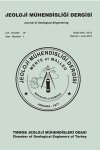
ABSTRACT: In this study, bearing capacity and settlement properties of the clay unit outcropping at foundation ofMersin City Sewerage Project site are calculated and the commonly used methods for the determinationof bearing capacity and the settlement properties were correlated. The information was used from 20boreholes opened in this context. Standart Penetration Tests (SPT) and Pressuremeter Tests (MPT) wereaccomplished in boreholes and a series of laboratory tests were carried out on disturbed and undisturbedsamples. The bearing capacity of the foundation was determined with pressuremeter, Terzaghi, Hansen,Meyerof, and Skempton methods. Initial and consolidation settlements were calculated in addition topressuremeter settlement calculations. Later, calculated bearing capacity and settlement values of clayunits from different methods were correlated. The results of the bearing capacity calculations of foundationclays give closer results with Terzaghi, Hansen, Meyerof and Pressuremeter methods but Skempton methodgives relatively low values due to the calculation with only cohesion parameters. Pressuremeter settlementvalues were the lowest results where initial and the consolidation settlement values were calculatedrelatively higher. Odeometer test is recommended for the litologic units which have long consolidationperiod. Care should be given for settlement calculations with the pressuremeter method.
ABSTRACT: CERCHAR Abrasiveness Index (CAI) plays an important role in determination of rock abrasivity. Themain factors affecting the abrasiveness of rocks are amount of hard minerals such as quartz, rock density, degree of cementation and strength characteristics. In this study, rock samples of Austin (Texas - USA) weretested, weak limestone samples were tested according to CERCHAR method and relationships betweenabrasiveness and the strength properties of the soft rocks were investigated. Considering abrasion of therock and steel together, wear on the steel and indentation on the rock that occur at the same time weremeasured and tried to be correlated. Potential usage of CERCHAR method, which is currently used forestimation of life of excavation tools, was investigated for prediction of strength properties of weak rocks.As a result of the study, CAI values of the limestone samples were found less than 1.72, while the majorityof the results was found in the range of 0.2 to 1. In this study a good relationship has been found amongCAI and UCS and TS values, by the statistical analysis of the test results. Another good relationship wasobserved between CAI and indentation depth (ID). Similarly, ID has good correlation with the UCS andTS. . CAI parameter used in the determination of rock abrasivity and CERCHAR method used to obtainit have been suggested be improved for the soft rocks. It is concluded that, in addition to CAI values, bymeans of indentation depth measurements in CERCHAR tests, prediction of other rock properties will bepossible.
ABSTRACT: Landslides are leading natural disasters occurring in the Black Sea Region, which is one of the regions receiving a great deal of rain and which is the roughest one in our country, particularly the Eastern Black Sea. In the region, the damage caused by landslides is greater than that caused by earthquakes in the long term. In this study, the landslides that occurred in Çayeli in July 2002 as a result of heavy rain were investigated and the landslide susceptibility map was prepared for the study area. Initially, a landslide inventory map was created and 149 landslides in total were mapped. Based on field investigations, the factors of lithology-weathering, slope angle, slope aspect, landcover, elevation and proximity to river were evaluated as the parameters causing the landslides. Using topographical and thematic maps, the parameter maps were created in Geographical Information Systems (GIS) environment,. Associating the maps with the current landslides, their frequency ratio values were determined. In the light of these evaluations, it is thought that completely weathered dacite and pyroclastics, and completely weathered andesite-basalt and pyroclastics are effective in the landslide occurrence. The slope classes between 0º and 20º, northward-northeastward slopes and the elevation classes between 0 and 200 m were regarded as significant according to the obtained values. Similarly, landcover classes from agricultural and settlement area, and proximity to river classes between 0 - 100 m are parameter classes considered significant in paired comparisons. Then, weighted values were calculated and by taking these values in to account, a landslide susceptibility map was created. Finally, to analyse the performance of the map, the current landslides and the susceptibility map were compared and 81% of current landslides were determined to be situated in susceptible, highly susceptible and very highly susceptible areas.
ABSTRACT: In the most of engineering geological and rock engineering applications, uniaxial compressivestrength (UCS) and elasticity modulus (E) of the intact rocks are the most widely used parameters. However, in some cases it can be quite difficult, time consuming and expensive to prepare specimens and toconduct this test. As an alternative, the empirical or analytical relationships between various physical andmechanical strength properties of materials can be used to estimate the required engineering propertiesof rocks. For these reasons, simple test method such as ultrasonic sonic velocity test is used widely. Thissimple test has been world widely used to estimate the UCS and E of the rock materials, because of theirrapidity, simplicity, portability, low cost, non-destructiveness and easiness in both specimen preparationand test conduction. In this study, simple test methods and UCS tests were conducted on the samplesobtained from the beige limestones outcropping in the southern zone of the eastern Pontides and somestatistical correlations were established between results of simple tests and UCS test results. Regardingthe test results obtained by the direct and indirect methods, meaningful statistical relations between therock properties are obtained.

 TMMOB
TMMOB